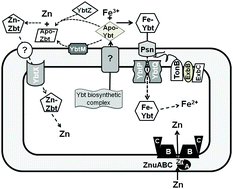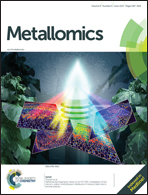Zinc transporters YbtX and ZnuABC are required for the virulence of Yersinia pestis in bubonic and pneumonic plague in mice†
Abstract
A number of bacterial pathogens require the ZnuABC Zinc (Zn2+) transporter and/or a second Zn2+ transport system to overcome Zn2+ sequestration by mammalian hosts. Previously we have shown that in addition to ZnuABC, Yersinia pestis possesses a second Zn2+ transporter that involves components of the yersiniabactin (Ybt), siderophore-dependent iron transport system. Synthesis of the Ybt siderophore and YbtX, a member of the major facilitator superfamily, are both critical components of the second Zn2+ transport system. Here we demonstrate that a ybtX znu double mutant is essentially avirulent in mouse models of bubonic and pneumonic plague while a ybtX mutant retains high virulence in both plague models. While sequestration of host Zn is a key nutritional immunity factor, excess Zn appears to have a significant antimicrobial role in controlling intracellular bacterial survival. Here, we demonstrate that ZntA, a Zn2+ exporter, plays a role in resistance to Zn toxicity in vitro, but that a zntA zur double mutant retains high virulence in both pneumonic and bubonic plague models and survival in macrophages. We also confirm that Ybt does not directly bind Zn2+in vitro under the conditions tested. However, we detect a significant increase in Zn2+-binding ability of filtered supernatants from a Ybt+ strain compared to those from a strain unable to produce the siderophore, supporting our previously published data that Ybt biosynthetic genes are involved in the production of a secreted Zn-binding molecule (zincophore). Our data suggest that Ybt or a modified Ybt participate in or promote Zn-binding activity in culture supernatants and is involved in Zn acquisition in Y. pestis.

- This article is part of the themed collection: Zinc in the Biosciences


 Please wait while we load your content...
Please wait while we load your content...